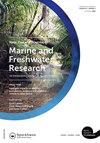The advantages and limitations of biophysical modelling as a tool for informing limit setting in New Zealand’s barrier-enclosed estuaries
IF 1.7
4区 环境科学与生态学
Q3 FISHERIES
New Zealand Journal of Marine and Freshwater Research
Pub Date : 2022-07-03
DOI:10.1080/00288330.2022.2102045
引用次数: 1
Abstract
ABSTRACT Estuaries are the receiving environment for catchment-derived contaminants, the fate of which depends on the interplay between the estuarine geomorphology and hydrodynamics. In large estuaries, biophysical processes are spatially and temporally-diverse, which makes understanding and managing the impact of human activities challenging. Here we use two common modelling approaches to explore the advantages and limitations of biophysical modelling as a tool for limit setting in a large barrier-enclosed estuary in New Zealand. The model shows the large spatial variation in water quality associated with low upper harbour flushing. Variations can also be attributed to spatial variation in processes (such as denitrification). Although the non-linear interactions between processes within these models can limit the value of using specific detail of outputs for decision making, the general patterns and sensitivities can be used to define areas, explore connectivity, and provide some information when monitoring data is lacking. Even in a deterministic modelling environment, it can very difficult to attribute water quality variations output at one location to the loading that caused these variations. While biophysical modelling will likely remain a core tool for informing management, any future development of limit setting methods for estuaries should recognise the inherent constraints we describe here.生物物理建模作为一种工具的优势和局限性,为新西兰的屏障封闭河口的限制设置提供信息
河口是流域污染物的接收环境,其命运取决于河口地貌和水动力学之间的相互作用。在大型河口,生物物理过程具有空间和时间上的多样性,这使得理解和管理人类活动的影响具有挑战性。在这里,我们使用两种常见的建模方法来探索生物物理建模作为新西兰大型屏障封闭河口限制设置工具的优点和局限性。该模型显示,与低上港冲水有关的水质空间差异很大。变化也可归因于过程(如反硝化)的空间变化。尽管这些模型中的过程之间的非线性相互作用可能会限制使用输出的特定细节进行决策的价值,但一般模式和敏感性可用于定义区域、探索连通性,并在缺乏监测数据时提供一些信息。即使在确定性建模环境中,也很难将一个地点的水质变化输出归因于导致这些变化的负载。虽然生物物理建模可能仍然是告知管理的核心工具,但任何未来河口限制设定方法的发展都应该认识到我们在这里描述的固有约束。
本文章由计算机程序翻译,如有差异,请以英文原文为准。
求助全文
约1分钟内获得全文
求助全文
来源期刊
CiteScore
4.50
自引率
12.50%
发文量
35
审稿时长
3 months
期刊介绍:
Aims: The diversity of aquatic environments in the southern continents and oceans is of worldwide interest to researchers and resource managers in research institutions, museums, and other centres. The New Zealand Journal of Marine and Freshwater Research plays an important role in disseminating information on observational, experimental, theoretical and numerical research on the marine, estuarine and freshwater environments of the region.

 求助内容:
求助内容: 应助结果提醒方式:
应助结果提醒方式:


